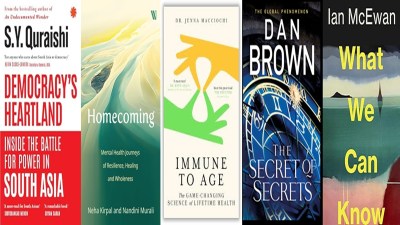When Médecins Sans Frontières (MSF) won the Nobel Peace Prize in 1999, the Russian military had bombed Chechnya in the preceding months causing tens of thousands of people to abandon their homes. In the same year, the international medical humanitarian organisation, called Doctors Without Borders in English, opened its office in India to work in the then undivided Bihar to fight malnutrition and later for emergency interventions in Odisha cyclone, Kerala floods, mental health in Kashmir, sexual and gender-based violence in Delhi, advanced HIV in Patna, drug-resistant tuberculosis in Mumbai and co-infections like HIV, TB and Hepatitis in Manipur.
Nearly a quarter-century later, an exhibition by MSF and Alliance Francaise is focusing on families fleeing their homes and neighbourhoods in South Asia, not because of bombing, but the fury unleashed by nature in climate change-induced crises. On World Humanitarian Day on August 19, three photography exhibitions at the Alliance Francaise in New Delhi—one, Humanity Heals, based on MSF’s own work in the region, and two, Climate Migrants, on the works of Bangladeshi artist Abir Abdullah. The Dhaka-based Abdullah, who first exhibited his photography works, on the Gorkha Earthquake in Nepal, at the Maya Art Space gallery in Kolkata in 2015, returned to India with 52 of his works, this time on the climate catastrophe in his own country.
Curated by author Ina Puri, Climate Migrants traces the devastation of floods and famine in Bangladesh. One image shows human figures in waist-deep water carrying a metal roof on their shoulders after a flood in northern Bangladesh. In another, a family is moving on a cycle-rickshaw packed with their belongings in the backdrop of a dark sky and a submerged Earth after Cyclone Aila in South Bangladesh in 2009. Yet another shows a woman cooking lunch on a banana raft outside her flooded home.
“I am a documentary photographer committed to document the important social, political and environmental issues of our society. But then, my role is not only to document the situation but more importantly to share it to the world to make the policy-makers, different stakeholders, politicians and civil society aware, educate, advocate and inform what is happening around us, so that the relevant groups can take action and make a change,” Abdullah, who was not able to travel to Delhi for the opening of the exhibition, told FE from Dhaka. “Climate change is affecting our collective world,” says curator Puri, who first met Abdullah at the Dhaka Art Summit in February this year. “Most of the artist’s portraits are of women— mothers, wives and young girls. There is resilience in their eyes. That is Mother Courage,” adds Puri.
The exhibition, which ended on Saturday, was all about witnessing the tragedy unfolding in the region, which has seen huge loss of lives and property in record rains and landslides in Himachal Pradesh and Uttarakhand in recent times. “At the beginning, our scientists were not so sure about the impact of climate change since Bangladesh is a flood-prone country. But when the frequency of flooding, cyclones and other storms increased they were certain about the reasons behind all the natural catastrophes, which is climate change. When covering cyclones, flooding and land erosion, I saw how people in remote and isolated places lost their homes and struggled to find a place to live. That ‘displacement’ intrigued me the most for pursuing this project,” explains Abdullah.
“Climate migration is not new. We are seeing the impact now. Climate change doesn’t happen overnight,” says Sana Bég, director of communication, MSF South Asia. “It’s World Humanitarian Day today, but for us it is World Humanitarian Day every day,” adds Bég. MSF’s Humanity Heals show put together photographs of its work across the region in an effort aimed at shifting the narrative on how people in need are portrayed. “They are refugees by circumstance,” says Bég. Launched in July this year, MSF’s Humanity Heals campaign in South Asia will run for one year. This was not the first time MSF brought art into its campaigns. Earlier this year, it sent a message of solidarity with displaced people across the world in a travelling puppet, Little Amal, belonging to a ten-year-old Syrian refugee. The third exhibition, side by side, an artistic collaboration between MSF and Turkish digital artist Ugur Gallenkus explored the challenges in addressing the question of fundamental rights through 30 collages created by the Istanbul-based artist.
Faizal Khan is a freelancer
Blurb: Curated by author Ina Puri, the Climate Migrants exhibition highlighted the devastation of floods and famine in Bangladesh. The other two exhibitions – Humanity Heals and Side by Side were curated by MSF.








